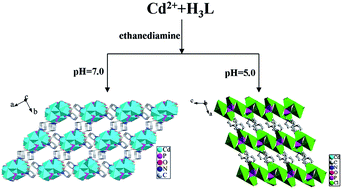Two novel cadmium(ii) carboxyphosphonates with 3D framework structure: synthesis, crystal structures, luminescence and molecular recognition properties†
Abstract
Two novel cadmium(II) carboxyphosphonates with 3D framework structure, namely, [Cd3(L)2(H2O)2] (1) and [Cd3Cl2(HL)2(H2O)2] (2) (H3L = H2O3PCH2–NC5H9–COOH) have been synthesized under hydrothermal conditions and structurally characterized. For compound 1, the interconnection of Cd(1)O5N, Cd(2)O6, and CPO3 polyhedra via edge- and corner-sharing forms a 1D chain. The adjacent chains connect with each other by sharing the carboxyphosphonate ligands, thereby generating a 2D layered structure. Neighboring layers are composed in a 3D pillared-layered structure by carboxyphosphonate ligands. Compound 2 exhibits a 3D framework structure. The Cd(1)O4Cl, Cd(2)O4Cl2, and CPO3 polyhedra are interconnected into a 2D layered structure in the bc-plane via corner-sharing, which is further linked to adjacent layers through carboxyphosphonate ligands to form a 3D framework structure. The luminescence properties of compounds 1 and 2 have been investigated. An interesting feature of compound 2 is that it is selective and reversible for sensing of acetone.


 Please wait while we load your content...
Please wait while we load your content...